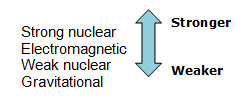
Before exploring the four fundamental forces, let’s first take a moment to review some basic understandings of forces.
A force is a push or a pull that can change the motion of an object or do work to change the energy of an object or system of objects.
Sometimes forces behave exactly like you would expect them to. This is the case with contact forces where two big objects push or pull on one another directly by touching or being connected by either a rope or a spring.
When distance separates the objects or objects are really small, like electrons or atomic nuclei, the forces may behave much differently from what you would expect.
Physics offers two explanations of how these forces work—field theory and carrier particle theory. Field forces are better explained by fields, and others are explained better by carrier particles. Unfortunately the two explanations don’t work together—current research is still looking for one explanation that describes the nature of all forces.
One way that scientists explain forces is through the idea of fields. A field is the effect that a particle has on the space around it because of its charge or its mass. The charge or mass of an object changes the space around it so that if you were to put another charge or mass near it, there would be a force. In the following demonstration, you will see the field that results from a strong charge.
In order to use the interactive on a full screen click the upper left hand corner. Click on the "Add +" button to add positive charges and the "Add – " button to add negative charges. Click on the blue or red circle to move the charges. The "Clear Screen" button is in the lower right hand corner.
Try each of the following to see how the field behaves:

![]() Electric Field Lines Interactive
Electric Field Lines Interactive
Pretend that you want to get a ball down that’s stuck in a tree 10 meters away. Force must be exerted, but the ball is out of your reach. You throw a small rock at the ball in hopes it will fall down. If you are successful, you will have exerted a force on the ball knocking it down from the tree, with the rock being the force carrier.
Particles can exert forces on each other in a similar way. Protons and electrons can exert electrical forces on each other by exchanging a particle called a photon. Depending on the type of photon and the charge of the particle that receives it, the force can be either a push or a pull.
All forces fall into one of four fundamental categories as noted earlier: gravitational, electromagnetic, strong nuclear, or weak nuclear. They have different degrees of strength, meaning that some are harder to break apart than others.
